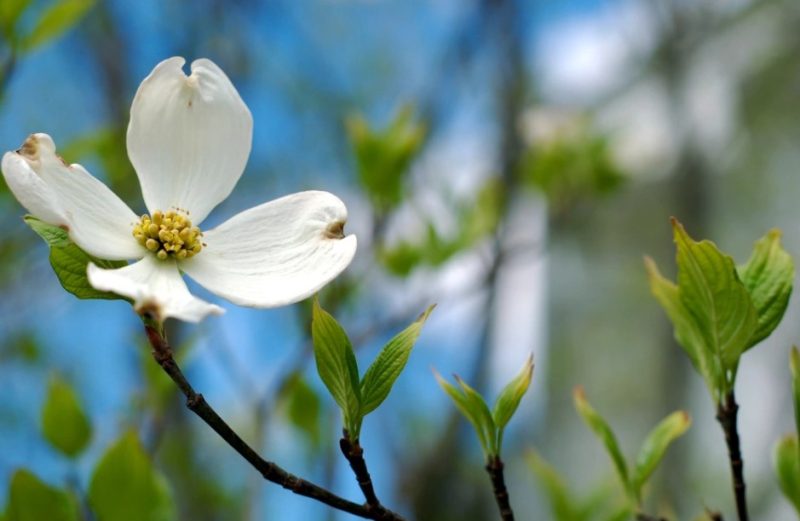Flowering Dogwood (Cornus florida) is a beautiful and iconic tree known for its stunning spring blooms, vibrant fall foliage, and appealing structure. Native to eastern North America, this ornamental tree adds elegance to landscapes and gardens.
If you’re considering adding this stunning plant to your outdoor space, this comprehensive guide will help you understand how to care for and grow Flowering Dogwood successfully.
What is Flowering Dogwood?

Flowering Dogwood (Cornus florida) is a deciduous tree that belongs to the Cornaceae family. It is renowned for its showy bracts, often mistaken for petals, which surround small clusters of yellowish flowers. These bracts are typically white, but some varieties showcase pink or red shades. The tree is admired not only for its springtime blossoms but also for its vibrant red foliage in fall and bright red berries that attract wildlife.
Why Grow Flowering Dogwood?
Growing Flowering Dogwood offers several benefits:
- Aesthetic Appeal: With its attractive flowers, fall foliage, and graceful branching pattern, it adds year-round beauty to landscapes.
- Wildlife Attraction: The red berries provide food for birds and small animals.
- Shade and Privacy: It can serve as a small shade tree or a privacy screen in garden settings.
- Native Plant Benefits: As a native species, it supports local ecosystems and is well-suited to the climate and soil of its natural range.
Types of Flowering Dogwood
Flowering Dogwoods (Cornus florida) are beloved for their stunning bracts, vibrant fall foliage, and elegant form. There are several popular varieties to choose from, each bringing its own unique charm to the landscape. Here are some of the most notable types:
Cornus florida ‘Cherokee Chief’
This striking cultivar is known for its deep pink to red bracts that beautifully contrast against its dark green foliage. In autumn, the leaves turn a vibrant red, enhancing the seasonal color in any garden. It typically grows to a height of 20 to 25 feet with a similar spread, forming an elegant rounded canopy. ‘Cherokee Chief’ is perfect as a specimen tree or as part of a mixed border, adding year-round interest with its reddish bark and red berries that attract birds in the fall.
Cornus florida ‘White Cloud’
For those seeking a classic and refined appearance, ‘White Cloud’ is an excellent choice. This variety showcases pure white bracts that elegantly float above rich green leaves, creating a cloud-like effect when in full bloom. It has a broad, rounded form and grows up to 20 feet tall and wide, making it ideal for smaller landscapes or as a focal point in a garden bed. In autumn, the foliage turns bronze to reddish-purple, adding a touch of warmth to the seasonal palette. Its white blooms are also known to appear slightly earlier than other varieties, extending the spring display.
Cornus florida ‘Rubra’
‘Rubra’ is a popular pink-flowering variety known for its soft pink bracts that sometimes deepen to a rose-pink hue. The flowers gracefully contrast against the dark green foliage, which turns a reddish-purple in fall, providing beautiful autumn interest. This variety reaches a height of 15 to 25 feet with a spreading habit, forming a picturesque silhouette. ‘Rubra’ is often chosen for cottage gardens, woodland settings, or as an accent tree due to its romantic and delicate coloration. Additionally, its red berries attract wildlife, making it a wonderful choice for bird lovers.
Cornus florida ‘Appalachian Spring’
Renowned for its disease resistance, particularly to dogwood anthracnose, ‘Appalachian Spring’ is a resilient choice for gardeners seeking a reliable and healthy tree. It features bright white bracts that form a stark contrast against its lush green foliage. In autumn, the leaves turn a vivid red, creating a dramatic fall display. This variety grows to about 15 to 20 feet tall with a rounded, spreading form. Its robust nature makes it ideal for challenging landscapes or areas prone to disease issues, while its brilliant fall color ensures year-round beauty.
Ideal Growing Conditions
To successfully grow Flowering Dogwood (Cornus florida), it’s essential to provide the right environmental conditions. When planted in an ideal setting, these trees reward gardeners with spectacular blooms, vibrant fall foliage, and overall healthy growth. Here’s what you need to know about creating the perfect habitat for Flowering Dogwood:
Location and Light Requirements
Flowering Dogwood naturally grows as an understory tree in woodland settings, meaning it thrives best with partial shade. It prefers a location that receives morning sunlight with afternoon shade, which helps protect the delicate bracts and foliage from intense midday heat. This placement also mimics the dappled light found in its native environment, reducing the risk of leaf scorch.
In cooler climates, Flowering Dogwood can tolerate full sun as long as it receives adequate moisture. When grown in full sun, especially in warmer regions, it’s crucial to provide consistent watering to prevent stress and leaf burn. Applying a layer of mulch around the base helps maintain soil moisture and moderate root temperatures, ensuring the tree remains healthy and vibrant.
Soil Requirements
To flourish, Flowering Dogwood requires well-drained soil with a slightly acidic pH ranging from 5.5 to 6.5. Good drainage is essential to prevent root rot, as the tree is sensitive to waterlogged conditions. If planting in heavy clay soil, consider amending the area with organic matter to improve drainage and aeration.
The tree also thrives in nutrient-rich soil, so it’s beneficial to enrich the planting area with compost or well-rotted manure. This organic matter enhances soil fertility and supports healthy root development. Additionally, applying a balanced, slow-release fertilizer in early spring can promote vigorous growth and abundant blooming.
Watering Needs
Consistent moisture is crucial for the successful establishment and growth of Flowering Dogwood. During the first few years, it’s important to keep the soil consistently moist but not waterlogged. Regular watering helps young trees establish deep, strong roots, making them more resilient to drought conditions later on.
The tree benefits from deep watering once a week during dry periods. This encourages the roots to grow deeper into the soil, increasing drought tolerance. To achieve this, water slowly at the base of the tree, allowing the moisture to penetrate the soil thoroughly. Using a soaker hose or drip irrigation system can help maintain the right moisture level without over-saturating the soil.
Mulching around the base of the tree—keeping the mulch a few inches away from the trunk—also helps retain soil moisture and regulate temperature. This practice not only conserves water but also reduces competition from weeds, creating a healthier growing environment for the tree.
How to Plant Flowering Dogwood
Proper planting is crucial for the health and longevity of Flowering Dogwood (Cornus florida). These beautiful trees are known for their vibrant spring blooms and stunning fall foliage. To ensure they thrive in your landscape, follow this step-by-step guide:
1. Choose the Right Time to Plant
Best Time:
The optimal time to plant Flowering Dogwood is in early spring or fall. During these cooler seasons, the tree experiences less stress from heat, and natural rainfall supports root establishment.
Why Timing Matters:
Planting in spring allows the tree to develop a strong root system before the summer heat. In fall, the tree can focus on root growth as it prepares for winter dormancy. Avoid planting during extreme temperatures to reduce transplant shock.
2. Prepare the Planting Site
Select the Location:
Flowering Dogwoods thrive in partial shade but can also tolerate full sun with adequate moisture. Choose a spot with well-draining soil and protection from harsh winds. Avoid areas prone to waterlogging, as this can lead to root rot.
Dig the Hole:
- Dig a hole that is twice as wide and as deep as the root ball. This provides ample space for roots to spread out.
- Ensure the sides of the hole are slightly sloped outward to encourage root growth.
Soil Preparation:
- Mix the native soil with compost or well-rotted organic matter. This enriches the soil with nutrients and improves drainage.
- Avoid adding fertilizers at this stage, as they can damage delicate new roots.
3. Planting Process
Position the Tree:
- Carefully remove the tree from its container or burlap wrapping, being cautious not to damage the roots.
- Place the tree in the center of the hole, ensuring the top of the root ball is slightly above ground level. This prevents the tree from settling too deep, which can cause root suffocation.
Backfill and Water:
- Backfill the hole with the prepared soil mixture, gently tamping it down to eliminate air pockets.
- Water the tree thoroughly to settle the soil and provide initial moisture.
- If the soil settles too much, add more soil to maintain the correct planting depth.
4. Mulching
Apply Mulch:
- Spread a 2-4 inch layer of mulch around the base of the tree, extending to the drip line (the area beneath the tree’s outermost branches).
- Avoid direct contact with the trunk, as this can cause moisture buildup and encourage pests or diseases.
Benefits of Mulching:
- Mulch helps retain soil moisture, regulates soil temperature, and suppresses weed growth.
- It also improves soil structure as it decomposes, promoting healthy root development.
5. Initial Care and Maintenance
Watering:
- Water the newly planted Dogwood deeply and regularly, especially during dry spells in the first growing season.
- Keep the soil consistently moist but not waterlogged.
Protection and Support:
- If planted in a windy area, consider staking the tree to provide stability until the roots are well established.
- Protect young trees from deer or rodents by installing a tree guard around the trunk.
Monitoring and Pruning:
- Regularly check for signs of stress, such as wilting or yellowing leaves.
- Light pruning can be done in late winter or early spring to shape the tree and remove any dead or damaged branches.
Flowering Dogwood Care Guide
Proper care ensures the health and beauty of Flowering Dogwood (Cornus florida). With the right attention to watering, fertilization, and maintenance, these elegant trees will thrive and continue to provide stunning blooms and vibrant foliage year after year. Here’s how to care for your Flowering Dogwood:
1. Watering
Young Trees:
- Water young Flowering Dogwoods regularly during the first one to two years after planting. This is crucial for establishing a strong and extensive root system.
- Provide 1-2 inches of water per week, either from rainfall or supplemental irrigation.
- Deep, slow watering is recommended to encourage roots to grow deeper into the soil. Use a soaker hose or drip irrigation system for even moisture distribution.
Mature Trees:
- Once established, mature Flowering Dogwoods are more drought-tolerant but still benefit from occasional deep watering, especially during prolonged dry spells.
- Water deeply every 2-3 weeks during dry periods to maintain soil moisture without causing waterlogging.
- Avoid frequent shallow watering, as this can lead to shallow root development, making the tree more vulnerable to drought stress.
Watering Tips:
- Water in the morning to reduce evaporation and allow foliage to dry before evening, minimizing the risk of fungal diseases.
- Always check the soil moisture by inserting your finger 2-3 inches into the soil. If it feels dry, it’s time to water.
2. Fertilization
Spring Feeding:
- Apply a slow-release, balanced fertilizer (such as 10-10-10 N-P-K) in early spring, just as new growth begins. This supports vigorous growth and abundant flowering.
- Spread the fertilizer evenly under the canopy, avoiding direct contact with the trunk, and water it in thoroughly.
Avoid Over-Fertilizing:
- Over-fertilization can lead to excessive leaf growth at the expense of flowers and increase the tree’s susceptibility to diseases and pests.
- Limit fertilization to once per year unless the tree shows signs of nutrient deficiency, such as yellowing leaves or stunted growth.
- Conduct a soil test every few years to monitor nutrient levels and adjust the fertilization routine accordingly.
Organic Alternatives:
- Organic compost or well-rotted manure can be used to improve soil fertility naturally.
- Apply a 1-2 inch layer of compost under the tree’s canopy in spring, lightly working it into the topsoil.
3. Pruning and Maintenance
Pruning Time:
- Prune Flowering Dogwood in late winter or early spring, before new growth starts. This allows the tree to heal quickly and minimizes stress.
- Avoid pruning during the growing season to prevent sap loss and reduce the risk of disease.
Remove Dead Branches:
- Regularly inspect the tree for dead, damaged, or diseased branches, especially after storms or harsh weather.
- Use sharp, clean pruning shears to make clean cuts just outside the branch collar (the swollen area where the branch meets the trunk).
- Proper removal promotes healthy growth and maintains the tree’s natural shape.
Improve Air Circulation:
- Thin out crowded branches to enhance airflow and light penetration, which reduces the risk of fungal diseases like powdery mildew and dogwood anthracnose.
- Focus on removing branches that cross or rub against each other to prevent wounds that invite disease and pests.
- Maintain an open canopy structure by selectively pruning smaller branches rather than heavy trimming, which can stress the tree.
Shaping and Aesthetics:
- Prune to maintain the tree’s natural form, avoiding drastic changes to its shape. Flowering Dogwoods have a graceful, rounded canopy that enhances landscape aesthetics.
- Limit pruning to no more than 25% of the canopy in a single season to avoid shock and preserve the tree’s energy reserves.
4. Pest and Disease Management
Common Pests:
- Watch for pests like dogwood borers, aphids, and scale insects.
- If detected, treat infestations promptly with insecticidal soap or horticultural oil.
Disease Prevention:
- Flowering Dogwoods are susceptible to powdery mildew and dogwood anthracnose.
- Improve air circulation through proper pruning, and avoid overhead watering to keep the foliage dry.
- Apply fungicidal sprays if symptoms appear, following product instructions carefully.
General Health Practices:
- Clean pruning tools before and after use to prevent disease spread.
- Remove fallen leaves and debris from under the tree to reduce fungal spore buildup.
Propagation of Flowering Dogwood
Flowering Dogwood (Cornus florida) can be propagated through seeds or cuttings, each method having its own requirements and benefits. Whether you prefer the natural approach of growing from seeds or the faster method of rooting cuttings, this guide provides detailed steps to successfully propagate this beautiful tree.
1. From Seeds
Propagating Flowering Dogwood from seeds is a rewarding but slower process. It allows for genetic diversity, which can result in slight variations in flower color and form. Here’s how to do it:
Collect Seeds:
- Timing: Collect seeds in the fall when the bright red berries are fully ripe. This usually occurs in late September to early October.
- Harvesting: Gently pick the berries from the tree or gather fallen berries from the ground.
- Cleaning the Seeds:
- Remove the pulp by soaking the berries in water overnight.
- Rub the softened pulp off the seeds, then rinse them thoroughly.
- Discard any floating seeds as they are likely not viable.
Cold Stratification:
- Flowering Dogwood seeds require a period of cold stratification to break dormancy and stimulate germination.
- Process:
- Mix the cleaned seeds with a moist medium such as sand, peat moss, or vermiculite. The medium should be damp but not soggy.
- Place the mixture in a sealed plastic bag and store it in the refrigerator at 34-41°F (1-5°C).
- Duration: Keep the seeds refrigerated for about 90 days. This mimics winter conditions and prepares the seeds for germination.
- Check periodically to ensure the medium remains moist and to look for signs of sprouting.
Planting:
- Timing: Sow the seeds in early spring once the danger of frost has passed.
- Soil Requirements: Use a well-draining soil mix containing equal parts of garden soil, sand, and compost. This provides the right balance of drainage and nutrients.
- Sowing Depth:
- Plant the seeds about ½ inch deep.
- Cover lightly with soil and water gently to settle the soil without displacing the seeds.
- Germination and Care:
- Place the containers in a bright, shaded location to avoid direct sunlight, which can dry out the soil.
- Keep the soil consistently moist but not waterlogged.
- Germination can be slow, taking anywhere from 6 weeks to several months, so be patient.
2. From Cuttings
Propagating from cuttings is faster than from seeds and ensures the new plant will be genetically identical to the parent tree. This method is ideal for preserving specific flower colors or other desirable traits.
Take Softwood Cuttings:
- Timing: Take cuttings in early summer when the new growth is still green and flexible but mature enough to snap when bent.
- Choosing the Cuttings:
- Select healthy branches from a disease-free parent tree.
- Cut 4-6 inch long stems just below a node (the point where leaves attach to the stem).
- Use sharp, sterilized pruning shears to prevent disease transmission.
- Preparing the Cuttings:
- Remove the lower leaves, leaving only the top two or three leaves to reduce moisture loss.
- If the remaining leaves are large, cut them in half to minimize water evaporation.
Rooting Medium:
- Dip the cut ends of the cuttings in rooting hormone powder to stimulate root development.
- Planting:
- Insert the treated cuttings about 2 inches deep into a well-draining rooting medium, such as a mix of equal parts sand and peat moss.
- Space the cuttings to allow good air circulation, which reduces the risk of fungal diseases.
Maintain Humidity:
- Flowering Dogwood cuttings require high humidity to prevent wilting and encourage rooting.
- Creating a Humid Environment:
- Cover the container with a clear plastic bag or place it in a propagation dome to retain moisture.
- Ensure the plastic does not touch the leaves by using sticks or wire supports.
- Placement and Care:
- Place the container in bright, indirect light to provide warmth without direct sun exposure, which can overheat and damage the cuttings.
- Keep the rooting medium moist but not soggy. Mist the cuttings as needed to maintain humidity.
- Ventilate periodically to prevent mold and fungal issues.
Root Development and Transplanting:
- Rooting Time: Cuttings typically take 6-10 weeks to develop roots, depending on environmental conditions.
- Checking for Roots:
- Gently tug on the cuttings to feel resistance, indicating root growth.
- Alternatively, check for new leaf growth, a sign that roots are supporting the cutting.
- Transplanting:
- Once rooted, transplant the cuttings into individual pots with a nutrient-rich potting mix.
- Gradually acclimate the young plants to outdoor conditions by placing them in a sheltered area before planting them in the garden.
3. Additional Tips for Successful Propagation
- Patience is Key: Propagating Flowering Dogwood, especially from seeds, requires patience as growth is typically slow in the first few years.
- Protect from Pests and Diseases: Keep seedlings and cuttings protected from pests like aphids and fungal diseases. Use organic insecticides or fungicides as needed.
- Hardening Off: Before transplanting young plants outdoors, gradually expose them to sunlight, wind, and fluctuating temperatures over 1-2 weeks.
Landscaping Uses for Flowering Dogwood
Flowering Dogwood is a versatile tree suitable for various landscaping purposes:
- Ornamental Specimen Tree: Perfect as a standalone focal point.
- Border Planting: Ideal for adding structure to mixed borders.
- Wildlife Garden: Attracts birds, butterflies, and pollinators.
- Shade Garden: Complements shade-loving plants like ferns and hostas.
Conclusion
Flowering Dogwood (Cornus florida) is a beautiful addition to any garden, offering seasonal interest with its lovely spring blooms, lush green summer foliage, vibrant fall colors, and bright winter berries. With the right care, including suitable planting location, watering, pruning, and disease management, this tree can thrive for decades.
Whether you want to enhance your garden’s aesthetic appeal, provide habitat for wildlife, or simply enjoy its seasonal beauty, Flowering Dogwood is an excellent choice. By following this comprehensive care and growing guide, you can ensure the health and vitality of this stunning ornamental tree.
Embrace the elegance of Flowering Dogwood and create a breathtaking landscape that celebrates the beauty of nature year-round!






